The rockhounding grapevine was all a buzz about a recent strike at
Diamond Hill. Sure enough, the owner, Chet Karwoski, confirmed to me that an area in the lower
(smoky) pit was producing large shiny smoky quartz crystals from an area recently uncovered
during a trackhoe dig at the site. Never wanting to be left out and always the curious one,
I took advantage of a day off for Veterans Day to visit Diamond Hill to see for myself what all
the fuss was about.
I arrived at the site bright and early Friday to find Dave Smith already digging
in the smoky pit. Before long, Don Brockway and Mike Galvin showed up to dig in various spots that
Dave had reserved for them. I know these guys pretty well having dug with them more than once in
the past. I settled on an available spot and started digging. After about
6 hours of moving mass quantities of earth, all I was able to find was a quartz vein that contained
relatively small crystal pockets. The quartz crystals were very pale smokies and none were
larger than about 1/2-inch wide - hardly keepers to me.
By early afternoon, Don started to find what appeared to be very nice
crystals in a large vein system that he was working. It didn't take long before Mike got into the
act, as he and Don took turns working the spot. They pulled out a bunch of very nice
crystals in plates and clusters until late afternoon when their output seemed to significantly
wane. Dave was the first to leave followed by Don and Mike who decided to call it a day around
3:30 PM. They told me that they wouldn't be coming back to Diamond Hill for a while and that it
would be alright with them if I poked around in the spot that they had been working. Although they
told me that the crystals seemed to be getting few and far between, I figured that it was
anybody's guess if they would start up again.
After about a half hour of digging, prying and busting rock, I began to pulling
out large plates and clusters of what appeared to be smoky quartz. As is most often the case with
Diamond Hill quartz, you seldom know exactly what you have until you take it home and clean it. The
material looked promising in the field, so I kept digging. Before the day was over, I pulled out
a whole bunch of rocks that I thought were, at the very least, worthy of dragging home to wash.
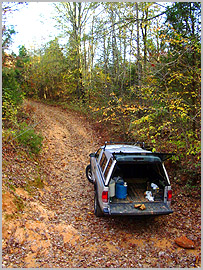
I had promised Chrissy that we would go back to Diamond Hill on Saturday, so
we got there early that day. While Chrissy scratched around in various locations, I continued working
the same area from where I had left off the day before. I hadn't had a chance to clean any of the
material that I had already dragged home, so I was pretty much working on faith, hoping that
the material that I recovered that day would be worth the trouble. Chrissy and I dug until
late afternoon, wrapped up a boatload of rocks in newspaper and headed for home.
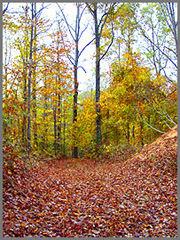
I spent much of Sunday in our driveway cleaning Diamond Hill rocks. With my handy
pressure washer, I was finally able to see if what we had dragged home was worth the past two day's
hard work. It didn't take me long to discover that we had hit the proverbial
jackpot. Hidden beneath a thick blanket of clay and rock fragments was an assortment of fantastic
specimens that are unlike anything that I have ever seen from anywhere, let alone Diamond Hill.
Needless to say, we were quite pleased with our take and with the volume of specimens that we
brought home. There there would be no need for us to go back anytime soon . . . at least that is
what I thought. . . After telling Jeff Deere about our finds, he was compelled to take a run at
Diamond Hill and he made the appropriate arrangements with Chet to go on Tuesday. When
one of Jeff's other digging partners canceled on the eve of his visit, naturally he
called me up and twisted my arm to join him there. Another vacation day bites the dust!

Jeff and I spent all day Tuesday working the same spot I had worked previously.
We had to tear down a large portion of the overhanging saprolite wall so that we could
follow the vein system without caving. Before the day was over, we carried out lots of rocks
that we hoped would end up being keepers after the clay was removed.
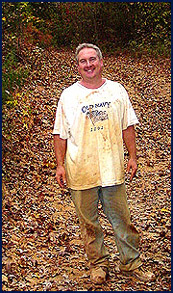
After working the area for several days, I decided that the area of quartz
crystallization is actually a silicified fault breccia. The faulting and brecciation most likely
took place as a result of series of late Paleozoic or early Mesozoic regional tectonic events. At
some point, silica-rich hydrothermal fluids entered a complex series of fractures within a fault
breccia and deposited quartz as veins and veinlets (thus the name, "silicified fault breccia").
Voids within the silicified fault breccia became sites for later quartz crystallization during a
series of subsequent hydrothermal events. The fault breccia appears to have partially collapsed;
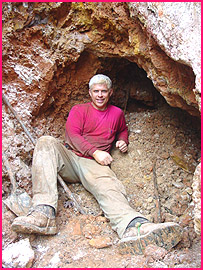 this may be due to weathering of the country rock and periods of quartz dissolution. There are
also smaller veins and vugs in the overlying and adjacent granitoid gneiss that must have collapsed
so that dark smoky quartz crystals and plates are found in white/gray saprolite (without red clay).
this may be due to weathering of the country rock and periods of quartz dissolution. There are
also smaller veins and vugs in the overlying and adjacent granitoid gneiss that must have collapsed
so that dark smoky quartz crystals and plates are found in white/gray saprolite (without red clay).
What may set the new smoky area apart from the other Diamond Hill quartz
varieties is how the geologic structure influenced the formation of the quartz - ie., the quartz
crystals formed in voids or vugs within or near a fault breccia. In addition, there must have also been a
 greater concentration of radioactive minerals within the country rock in the dark smoky area as
compared to where lighter smokies formed. Greater or prolonged exposure to radioactivity and
differing compositions of the hydrothermal solutions likely resulted in darker smokies. This
exact process with all its many variables is not completely understood by scientists. While
digging, it seemed to me that the darkest
smokies were ones that we recovered directly from the saprolite (weathered country rock). These
were in collapsed vugs and with white/gray kaolinite instead of red clay. Crystal zoning, or
internal alternating dark and light parallel bands that mirror the crystal shape, suggests that
the chemical composition, temperature and/or other factors within or affecting the hydrothermal
fluids must have been in flux during crystallization.
greater concentration of radioactive minerals within the country rock in the dark smoky area as
compared to where lighter smokies formed. Greater or prolonged exposure to radioactivity and
differing compositions of the hydrothermal solutions likely resulted in darker smokies. This
exact process with all its many variables is not completely understood by scientists. While
digging, it seemed to me that the darkest
smokies were ones that we recovered directly from the saprolite (weathered country rock). These
were in collapsed vugs and with white/gray kaolinite instead of red clay. Crystal zoning, or
internal alternating dark and light parallel bands that mirror the crystal shape, suggests that
the chemical composition, temperature and/or other factors within or affecting the hydrothermal
fluids must have been in flux during crystallization.
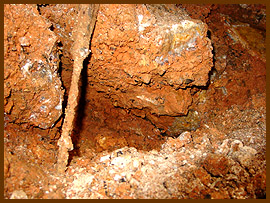
The only downside to this particular geologic environment is that a relatively
high percentage of recovered crystals end up being damaged no matter how careful the digger.
I believe that the high damage rate
is because the silicified fault breccia is a mixed up mess of crystals, veinlets
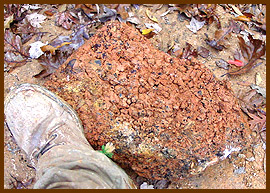 and rock fragments. Since there are very few actual clean pockets and the clay is "contaminated"
with what is essentially "shrapnel" made up of quartz and rock fragments, it is difficult to
impossible to pull out most plates and clusters
without hitting something else. It is also possible that any pressure from above, such as
from a trackhoe, may have caused further collapse of the fault breccia, thus resulting in some
crystal damage. Despite all this, we ended up with plenty of undamaged specimens of all shapes,
sizes and colors, as you will see in the following pictures.
and rock fragments. Since there are very few actual clean pockets and the clay is "contaminated"
with what is essentially "shrapnel" made up of quartz and rock fragments, it is difficult to
impossible to pull out most plates and clusters
without hitting something else. It is also possible that any pressure from above, such as
from a trackhoe, may have caused further collapse of the fault breccia, thus resulting in some
crystal damage. Despite all this, we ended up with plenty of undamaged specimens of all shapes,
sizes and colors, as you will see in the following pictures.